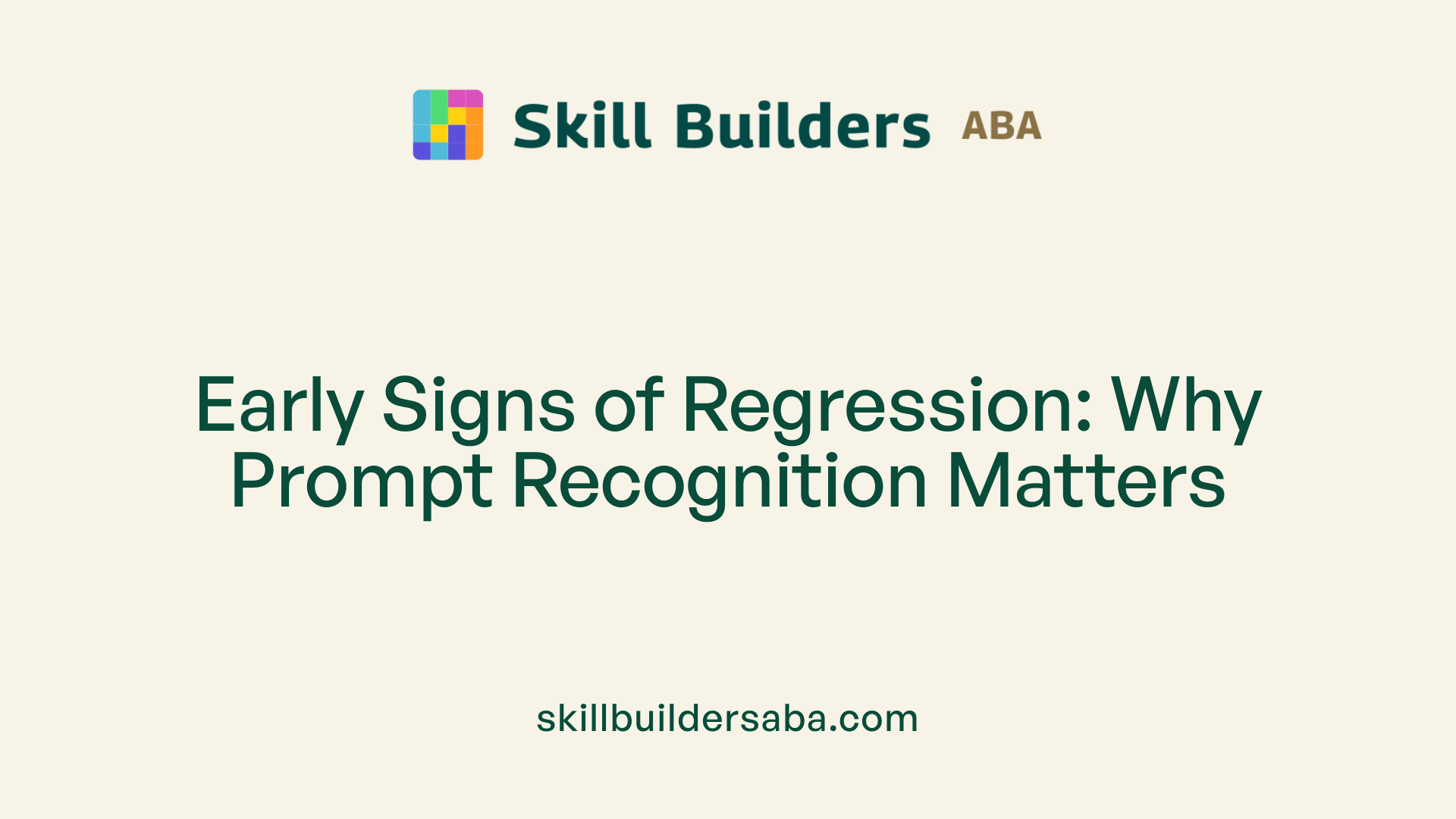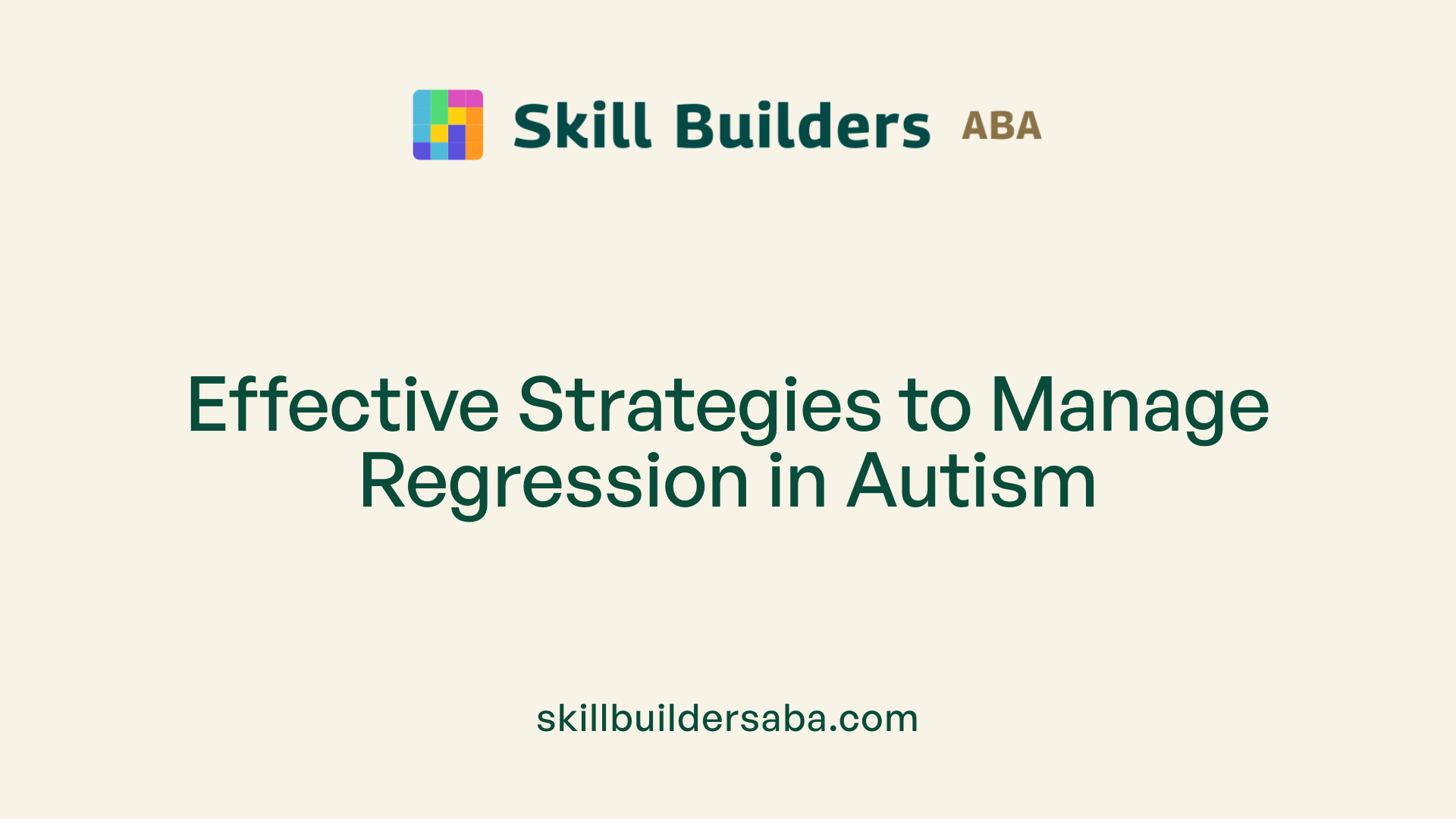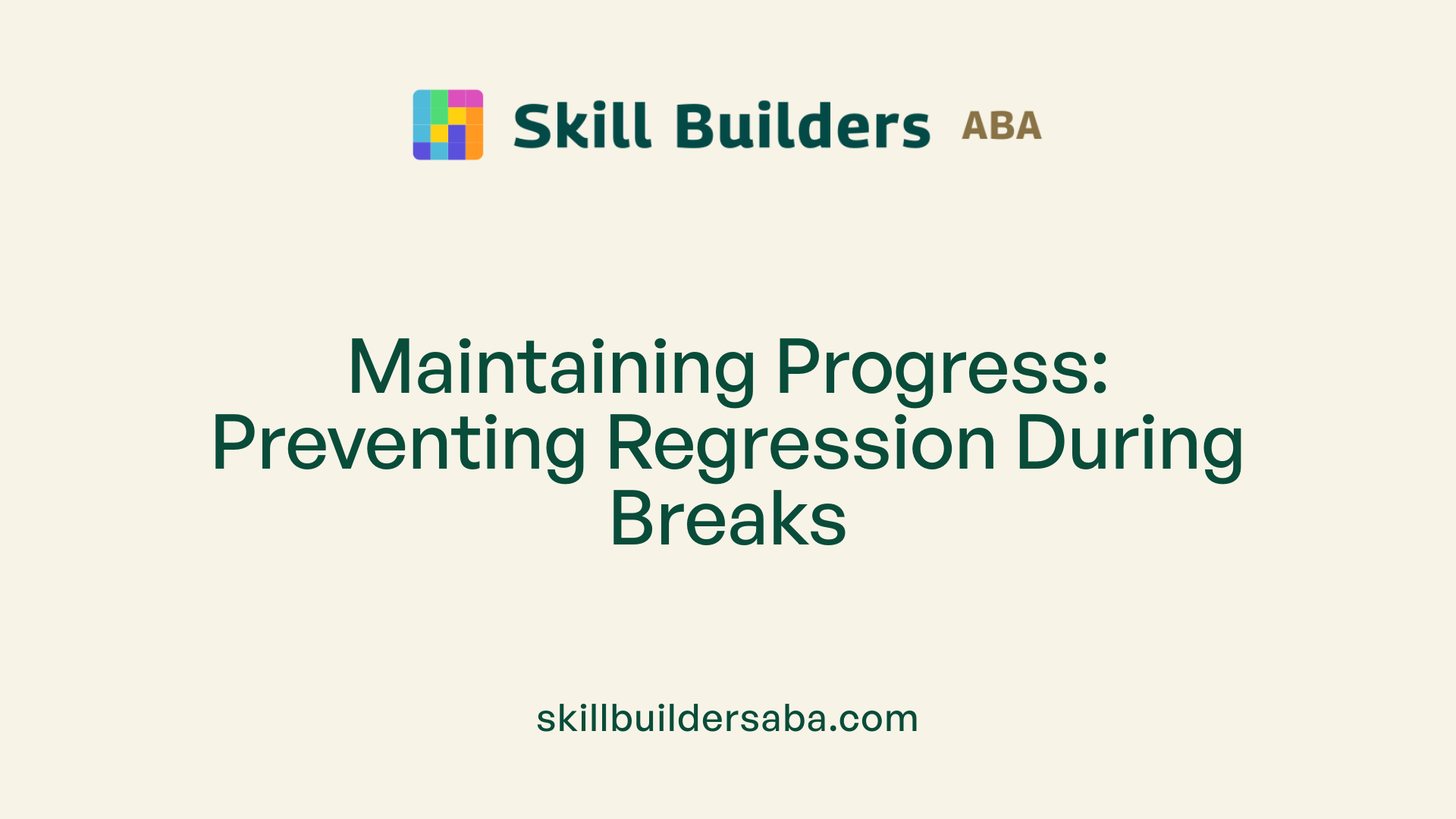
How to handle regression in children receiving ABA
Supporting Your Child Through Regression in ABA Therapy
Understanding and Managing Regression in Children with Autism
Behavioral regression in children with autism receiving ABA therapy can be challenging, yet with proper understanding and strategies, caregivers and professionals can effectively support these children. This article explores the signs, causes, management strategies, prevention techniques, evidence-based interventions, and caregiver education approaches to handle regression effectively.
Recognizing Signs and Causes of Regression in Autism
 Children with autism spectrum disorder (ASD) may experience a phase called regression, typically occurring between 15 and 30 months of age. Recognizing the early signs of this regression is vital for prompt intervention and support.
Children with autism spectrum disorder (ASD) may experience a phase called regression, typically occurring between 15 and 30 months of age. Recognizing the early signs of this regression is vital for prompt intervention and support.
Signs of regression often include a noticeable loss of communication skills, such as reduced eye contact, decreased response to their name, and loss of speech or language abilities. Social engagement can diminish, with children becoming more withdrawn and less responsive to social cues. Repetitive behaviors and restricted interests may intensify, and there can be an increase in tantrums or emotional outbursts. Additionally, some children show regressions in motor skills, sleep patterns, or eating habits.
The causes of regression are diverse and not yet fully understood. Factors include genetic predispositions and neurological changes. Environmental influences, immune system problems, illnesses, or stress may contribute to regression episodes. It is believed that underlying biological factors, along with external stressors, can trigger changes in brain development that lead to the loss of previously acquired skills.
Detecting regression early requires careful developmental monitoring and assessment tools. Standardized instruments like the Autism Diagnostic Observation Schedule (ADOS) and the Modified Checklist for Autism in Toddlers (M-CHAT) are useful for early detection. Recognizing these signs promptly enables caregivers and clinicians to initiate interventions such as applied behavior analysis (ABA) and other therapies to help children recover lost skills.
Understanding the multifactorial causes and early signs of regression allows for better management strategies. With appropriate and timely support, many children can regain lost abilities and continue making developmental progress, though ongoing research seeks to better understand long-term outcomes and strategies to sustain improvements.
Strategies for Managing and Addressing Regression Behaviors

What strategies can be used to manage and address regression behaviors during ABA therapy?
Handling regression in children with autism during ABA therapy requires a comprehensive approach that focuses on understanding the child's individual needs and circumstances. One crucial step is identifying the underlying causes of regression, which may include environmental changes, health issues, sensory sensitivities, or emotional factors. Addressing these root causes helps in creating targeted strategies to support the child's development.
Maintaining consistent routines and visual supports plays a significant role in providing stability. Picture schedules, visual cues, and structured daily activities help children predict what to expect, reducing anxiety and preventing skills from slipping away. This consistency fosters a sense of security, making it easier for children to retain and practice learned skills.
Incorporating natural environment teaching and engaging activities also enhances learning. These methods involve teaching skills in everyday settings using fun, motivating activities that reflect the child's interests. Examples include using favorite toys or activities to reinforce communication and social skills, which can make skill acquisition more meaningful and sustainable.
Collaboration between therapists and caregivers is essential for a cohesive approach. When parents and professionals work together, they can adjust interventions as needed, reinforce skills consistently across different environments, and respond promptly to signs of regression. Open communication ensures that strategies are tailored and effective.
Regular progress monitoring through data collection is vital. Using charts and logs to track skill development and behaviors provides insight into what is working and what may need modification. Involving parents in goal setting and data analysis helps in maintaining alignment and adjusting strategies to support ongoing progress.
In summary, managing regression behaviors during ABA therapy involves understanding individual causes, ensuring routines and supports are stable, using engaging teaching methods, collaborating effectively, and consistently tracking progress. These approaches help promote resilience, skill retention, and long-term development for children with autism.
Preventing Regression During Breaks and Vacations

How can regression be prevented in children undergoing ABA therapy, especially during breaks like summer?
Maintaining progress during breaks is a challenge for many caregivers and practitioners, but it is possible with strategic planning and consistent effort. When children pause their formal ABA sessions during summer or other vacations, it is vital to keep intervention strategies personalized to their needs.
One effective approach is to continue with routines and visual supports that the child recognizes. These tools help sustain a sense of familiarity and reduce the likelihood of skill loss. Summer programs specifically tailored to ABA, available in many communities, provide a natural environment where children can practice skills recovered during therapy.
Community activities, such as sports, arts, and social groups, offer opportunities to generalize skills in real-life situations. These settings encourage social interaction and reinforce positive behaviors outside the therapy environment.
Parental involvement remains crucial. Home practice of skills, set goals, and daily routines ensures consistent reinforcement. Educating and empowering parents to implement ABA strategies helps embed learning and prevents regression.
Incorporating outdoor activities and engaging with social skills groups can further support skill retention. These experiences foster independence, problem-solving, and social interactions that are vital for overall development.
Continuous data collection and progress monitoring during breaks are essential. Regular assessments allow caregivers and therapists to identify potential regressions early and adjust strategies accordingly, ensuring skills are maintained and built upon.
By combining these strategies—consistent routines, community engagement, active parental participation, and ongoing assessment—children can retain their gains during breaks and transitions, paving the way for continued progress in their development.
Evidence-Based Approaches to Support Regression Management

What evidence-based approaches support children experiencing regression?
Managing regression in children with autism requires a multifaceted and evidence-based strategy. One of the primary steps is conducting functional behavior assessments (FBAs). These assessments help identify the underlying causes of regression, such as sensory sensitivities, communication difficulties, or environmental triggers. Based on these insights, tailored reinforcement strategies can be implemented to promote skill retention and encourage new learning.
Early intervention is vital. This includes customized therapies like speech therapy, occupational therapy, and developmental interventions designed to target specific areas of skill loss. For instance, speech therapy often employs visual aids like picture cards and reinforcement techniques to rebuild verbal communication skills. Occupational therapy targets motor skills and sensory integration issues.
Behavioral interventions, such as cognitive-behavioral therapy (CBT), hold significant evidence for managing related mental health concerns like anxiety or problematic behaviors. Parent training programs empower caregivers with techniques to support their child's development and manage regression effectively.
Medical evaluation may be necessary when regression is linked to underlying medical, neurological, or psychiatric issues. Pharmacologic options like antidepressants, antipsychotics, or benzodiazepines can sometimes help alleviate symptoms or comorbid conditions, but these are used cautiously and alongside behavioral therapies.
Family support forms a cornerstone of effective management. Providing reassurance and guidance helps caregivers navigate their child's regression with confidence. Engaging children in symbolic and imaginative play not only fosters emotional expression but also stimulates developmental progress.
These approaches are supported by research indicating positive outcomes across cognitive, language, social, and behavioral domains after intervention. Nonetheless, further studies are needed to measure long-term effects and how skills generalize across different settings, emphasizing the importance of ongoing, comprehensive care.
Educating Parents and Caregivers About Regression
Understanding autism regression and knowing how to manage it are essential aspects for parents and caregivers. Well-designed educational programs, such as the Caregiver Skills Training (CST) developed by the World Health Organization (WHO) and Autism Speaks, offer foundational tools to support families. These programs are accessible at no cost and focus on empowering caregivers through practical, everyday routines and play strategies.
One of the main goals is to help caregivers recognize early signs of regression. This can include the loss of language abilities, social engagement, or motor skills, typically occurring between 15 and 30 months of age. Early identification through observation and professional assessments is vital for timely intervention.
Strategies to support children during regression episodes involve reinforcing desired behaviors and promoting developmental skills. For example, using picture cards and visual schedules can encourage communication and behavioral stability. Consistent routines and positive reinforcement are also crucial in helping children regain lost skills.
Professional involvement remains fundamental. Regular assessments by multidisciplinary teams guide intervention plans and optimize outcomes. Access to community resources and therapies like Applied Behavior Analysis (ABA) are vital, as they can help children recover skills effectively.
Supporting caregivers' well-being is equally important. Managing the emotional stress of caring for a child with autism benefits from ongoing communication with therapists and participation in support groups. Tools such as the CarerQol measure and other self-care strategies help caregivers monitor their mental health and resilience.
Ultimately, increasing caregiver knowledge, offering access to resources, and fostering community support create an environment where children experiencing regression have the best chance for recovery and continued growth. Early diagnosis and sustained intervention are the cornerstones of improving long-term outcomes.
Long-Term Outlook and the Need for Further Research
Why are follow-up assessments and mastery measures important in ABA?
Understanding whether children truly retain and generalize skills learned through ABA is essential for evaluating the therapy’s effectiveness over time. Follow-up assessments help track progress after initial intervention and ensure that gains are maintained. Measures of mastery define specific criteria that determine when a child has successfully acquired a skill, providing clear benchmarks for progress. This focus helps tailor ongoing therapy and adjust strategies as needed.
How does skill generalization across different settings influence outcomes?
Most research to date has concentrated on immediate improvements within controlled environments. However, skills learned in therapy must transfer to home, school, and community settings to be truly valuable. Generalization measures assess whether children can apply these skills in various contexts, which is critical for independence and functional living.
What are the limitations of current research, and why is there a need for larger studies?
Despite promising findings, many existing studies feature small sample sizes, short follow-up periods, and limited scope regarding long-term impacts. These limitations hinder our understanding of how sustainable and broad-reaching ABA benefits are. There is a pressing need for large-scale, prospective studies that monitor children over extended periods, incorporate diverse populations, and include rigorous assessments for maintenance and generalization.
What are the long-term benefits of ABA therapy?
Evidence indicates that early and consistent ABA intervention can lead to lasting improvements in communication, social skills, and behavior. Children may achieve greater independence and quality of life, although specific outcomes vary. Notably, improvements are observed across cognitive, language, and emotional domains, which can help children better navigate daily life.
Why is there a call for more comprehensive research?
To optimize ABA’s effectiveness, future studies should encompass long-term effects, include larger and more diverse populations, and assess quality of life and functional independence. Emphasizing follow-up, mastery of skills, and generalization will clarify how consistent and durable these benefits are. Integrating these focus areas into research protocols will support the development of more personalized and effective interventions.
Supporting Approach for Children Experiencing Regression Evidence-based strategies include conducting functional behavior assessments to identify underlying causes of regression, deploying reinforcement techniques to promote skill retention, and implementing early, tailored therapies like speech and occupational therapy. Behavioral interventions such as cognitive-behavioral therapy and parent training are also effective, especially for addressing related mental health issues like anxiety. Medical evaluations may be necessary to manage underlying neurological or psychiatric conditions, with medications used judiciously. Family support and playful interactions help children process their regression and regain developmental milestones, facilitating a comprehensive recovery plan.
Understanding the Impact of Socioeconomic and Regional Factors
 Barriers to accessing Applied Behavior Analysis (ABA) for children with autism are complex and multifaceted. Geographic location plays a significant role, with disparities in the availability of qualified ABA providers across regions. Families in urban areas often have better access, while those in rural areas face considerable challenges in locating appropriate services.
Barriers to accessing Applied Behavior Analysis (ABA) for children with autism are complex and multifaceted. Geographic location plays a significant role, with disparities in the availability of qualified ABA providers across regions. Families in urban areas often have better access, while those in rural areas face considerable challenges in locating appropriate services.
Economic situation and caregiver education levels heavily influence whether children receive ABA. Higher income and higher educational attainment among caregivers are associated with increased likelihood of accessing this therapy. This suggests that socioeconomic status can both directly and indirectly affect the treatment opportunities for children with ASD.
Caregiver attitudes also matter. Belief in the effectiveness of ABA, a sense of empowerment, and comfort with navigating healthcare systems increase the chances of children receiving appropriate intervention. Caregivers diagnosed with their child's autism earlier tend to be more proactive in seeking treatment, thus increasing ABA access.
A survey of 540 caregivers highlighted these barriers, revealing that many families face obstacles related to location, income, education, and their confidence in managing healthcare needs. Overcoming these barriers requires targeted efforts to improve information dissemination, service availability, and caregiver support.
| Factor | Impact on ABA Access | Additional Details |
|---|---|---|
| Location | Varies by region, affects provider availability | Urban vs rural disparities |
| Income | Higher income correlates with increased ABA receipt | Affords better access and resources |
| Education | Higher education linked to more treatment | Enhanced understanding and empowerment |
| Caregiver belief | Strong belief in treatment promotes access | Influences decision to pursue ABA |
| Caregiver empowerment | Greater empowerment increases likelihood of ABA initiation | Confidence in managing therapy |
| Comfort level | Higher comfort facilitates access | Reduces hesitation and logistical barriers |
Efforts to improve access need to be multifaceted, addressing socioeconomic disparities, expanding provider networks, and empowering caregivers through education and support. This holistic approach can help ensure that more children with autism benefit from effective early interventions like ABA.
Moving Forward: Supporting Children and Empowering Caregivers
Addressing regression in children receiving ABA therapy requires a comprehensive approach that includes early detection, individualized management strategies, prevention during breaks, evidence-based interventions, and caregiver education. Recognizing the multifactorial causes and barriers related to socioeconomic and regional disparities is vital for improving access and outcomes. Ongoing research and long-term follow-up are essential to refine techniques, ensure the generalization of skills, and ultimately enhance the quality of life for children with autism and their families. Building community awareness, supporting caregiver well-being, and fostering a collaborative, multidisciplinary effort will help navigate the challenges of autism regression effectively.
References
- Barriers to Receiving Applied Behavior Analysis Services in ...
- Regressive Autism: Why It Occurs
- Why Does Autism Regression Happen & How Can I Support My ...
- Applied Behavior Analysis in Children and Youth with Autism ...
- Regressive Autism: Why It Occurs
- Applied Behavior Analysis in Children and Youth with Autism ...
- Exploring Regressive Autism in Children - Move Up ABA
- Regression in autism: Signs, causes, and support
- Should ABA Therapy Continue During the Summer?
Reach Out Today
Learn more about how we can support your child’s growth and development. Contact us to discuss our services and availability in your area.
.svg)